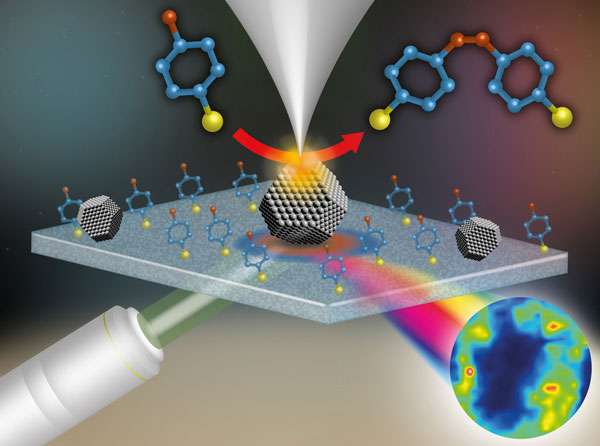Exploring catalytic reactions at the nanoscale

The National Physical Laboratory (NPL) has used a novel imaging capability - tip-enhanced Raman spectroscopy - to map catalytic reactions at the nanoscale for the first time.
Catalysts are substances that facilitate chemical reactions without being consumed, enabling industry to produce chemicals which would otherwise be uneconomic or even impossible. Catalysts are used in over 90% of industrial chemical processes, from the production of pharmaceuticals to energy generation, and are thought to contribute to over 35% of global GDP
Pressure for greener, cheaper and more sustainable chemistry in industry is driving the search for new catalysts with improved efficiency and selectivity. Rational design of catalyst materials with tailored properties relies on our ability to identify active sites at reacting surfaces in order to understand structure-performance relationships. However, conventional analytical techniques often lack the required sensitivity at the necessary length-scales for this to be achieved.
Tip-enhanced Raman spectroscopy (TERS) has emerged as a powerful and reliable technique for characterising surfaces at the nanoscale, combining the high chemical sensitivity of surface-enhanced Raman spectroscopy and nanoscale spatial resolution of scanning probe microscopy Together, these properties make TERS ideally-suited to the characterisation of catalytic reactions at the nanometre length-scale.
A team from NPL has taken the lead in using TERS to identify catalytic nanoparticles on a surface and has achieved nanoscale mapping of catalytic activity for the first time. The nanometre resolution of this reactive spectroscopic imaging, published in the Royal Society of Chemistry journal Nanoscale, has yet to be matched by any other analytical technique.
The team's work is hoped to pave the way for the routine use of TERS to study catalytic reactions with nanoscale resolution. In the future, the spatial variations identified using this technique could provide powerful new insights into molecular adsorption and reaction dynamics at surfaces, ultimately enabling improved control and efficiency of chemical processes through informed catalyst optimisation.
More information: "Nanoscale mapping of catalytic activity using tip-enhanced Raman spectroscopy." Nanoscale, 2015,7, 7133-7137 DOI: 10.1039/C4NR07441F
Journal information: Nanoscale
Provided by National Physical Laboratory




















